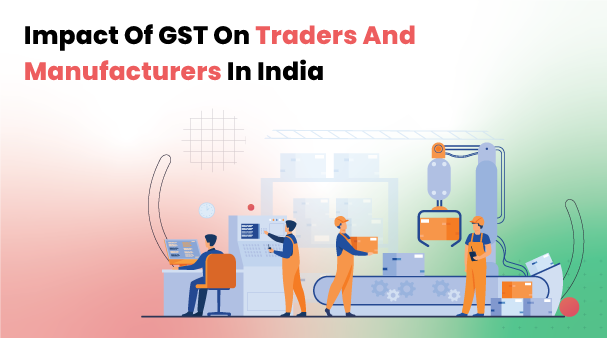GST’s impact on traders and manufacturers in India includes the elimination of the cascading effect, the composition scheme for small traders, consolidation of the erstwhile indirect tax laws, etc.
GST provided multiple benefits to the manufacturers and traders. While overcoming the shortcomings of the erstwhile indirect taxation regime, it streamlined the indirect taxes. However, GST certainly has its own set of compliances. To ensure timely and accurate compliances, Wepsol provides a complete GST compliance software meeting all the needs of the GST for traders and manufacturers. Check it out now!
After the implementation of GST in India on 1st July 2017, the indirect tax underwent a drastic change. There was a significant impact of GST on traders and manufacturers in India. Things got streamlined as both the goods and services got covered under a single law, unlike the erstwhile Service Tax Act for services and VAT for goods. Let’s understand the Impact of GST on manufacturers and traders in India in detail.
What are the Impacts of GST?
Businesses experienced multiple benefits of GST in India. GST streamlined the entire indirect tax structure by consolidating all the erstwhile indirect tax laws into one. Earlier, for manufacturing, excise was applicable, whereas, for selling goods, VAT and CST were applicable. When it came to services, the Service Tax Act was applicable. Problems arise when a single transaction is classified as both supplies of goods and services. This also led to multiple instances of double taxation due to cascading effect, the lapse of credit, etc., thereby causing loss to the registered person. All such difficulties were removed after the introduction of GST.
Impact of GST on Traders
Traders are specifically people dealing in the purchase and sale of goods. More often than not, service providers also get covered under the traders, which are considered trading in services. The GST law has simplified the indirect taxes for traders. Following are the major impact of gst on trading sector in india:
● Earlier, if the trader had to sell goods within the state, he had to pay VAT, whereas, in the case of an inter-state sale, CST was applicable. However, with GST, sales within the state are liable to CGST and SGST, whereas, for sales outside the state, IGST became applicable.
● For trading in services as well, the concept remains the same. GST shall be levied based on whether the service is provided within or outside the state.
● The cascading effect has been removed. The ITC on inward supply of goods or services can be set off against outward supply of goods and services. The only bar is that CGST cannot be set off against SGST. As the ITC gets set off against output tax liability, there is no cascading effect, thereby eliminating double taxation.
● Invoices under GST shall contain all the particulars prescribed by the GST law. Further, in case the turnover exceeds Rs. Twenty crores, then e-invoicing shall become applicable.
● For transporting goods with a value exceeding Rs. 50,000, the e-way bill shall be generated.
How Has GST Affected Small Traders?
GST for small traders in india becomes mandatory if the turnover exceeds Rs. 20 lakhs during the financial year. In case of an exclusive supply of goods, the limit applicable shall be Rs. 40 lakhs. Therefore, small traders with turnover lower than the above threshold limit shall not be required to undertake GST registration. However, they can opt for voluntary registration under GST.
Further, the GST law has a special scheme for small traders known as the composition scheme. Under the composition scheme, the trader only needs to file CMP-08 on a quarterly basis to discharge the tax liability on a self-assessed basis. After the financial year ends, you need to file your GST return in Form GSTR-4 by 30th April. You can opt for a composition scheme if your aggregate turnover does not exceed Rs. 1.50 crores during the financial year.
Impact of GST on Manufacturing in India
Excise law was the predominant indirect tax applicable for manufacturing in India. However, after introducing the GST law, now GST shall be applicable. Following is the gst impact on manufacturing sector
● While in the erstwhile excise law, the point of taxation was the removal of goods, under GST, the point of taxation is the supply of goods. The concept remains the same here: CGST and SGST shall be levied for intra-state supplies, whereas IGST shall be levied for inter-state supplies.
● There has been a significant fall in the production costs as the manufacturers can avail of the ITC to purchase raw materials used for the production and manufacturing of goods.
● A single registration is required within the state for all the factories. However, registration was required for each factory, which is now done away with.
● Earlier, due to applying multiple laws like excise, VAT, CST, etc., the manufacturers had to solve lengthy queries and assessments. With the introduction of GST, compliance has become far easier for the manufacturers in India.
● However, most manufacturers ask a pertinent question – Can manufacturers do trading in GST?
● The answer is Yes! GST registration is taxpayer-wise and state-wise and not business or product-wise. Therefore, a manufacturer can indulge in the trading of goods as well. There is no bar under GST to continue only a particular activity based on which GST registration was obtained.
This transformation is a strong indicator of how the GST framework functions as a robust gst compliance software environment, enhancing efficiencies across the business vertical in gst.
How to Calculate GST on Manufacturers?
Calculating GST on the manufacturer is simple. The GST shall be levied on the taxable value of the goods or services or both. The rate of GST is based on the goods sold by the manufacturer. Different goods attract different rates of GST and are classified based on the HSN code.
How to Add Manufacturing to GST?
While obtaining GST registration, you shall select the nature of your business activity whereby multiple options are provided. You shall select manufacturing from that. If you are already a registered person and want to select a manufacturing activity, the GST portal allows you to select your core business activity once you log in. You are provided with three options, i.e., Manufacturer, Trader, or Service Provider. You can select the manufacturer here.
Note for the client: The writer has clubbed the information on e-invoice and e-bill here.
Benefits of Wepsol GST Software for Manufacturers and Traders in India
GST compliances are not a one-time activity but an ongoing exercise around the year. Therefore, most traders and manufacturers prefer GST tracking software to ease their compliances and ensure accuracy in furnishing GST data. However, they often get confused as to which software should be selected.
Wepsol GST software has been pioneering in helping traders and manufacturers ease their GST compliances. Following are the benefits of Wepsol GST software:
- Experience 6000 invoices matching at once
- Takes care of all your monthly, quarterly, and annual GST compliances
- 3 step return filing – Validate, Upload and Save
- Comprehensive description for errors and quick resolution
- Reconciliation and discrepancy resolution of ITC at both summary level and supplier level
- MIS report generation
- 256-Bit data security
- E-way bill solution
- E-invoicing solution: For those seeking robust gst e invoicing software or e invoicing gst software, this feature is essential.
- Various comparison report generation for analysing and making informed decisions
Above was just the tip of the iceberg you can experience with Wepsol GST Software. Non-compliance with GST can lead to a levy of penal charges and interest. Therefore, it is important to ensure GST compliance in a timely and accurate manner. Are you GST compliant?
If you are in search of a comprehensive gst solution and top-notch gst tracking software that meets all your compliance needs, Wepsol GST Software is designed to support your entire business vertical in gst while ensuring seamless integration with your processes.

